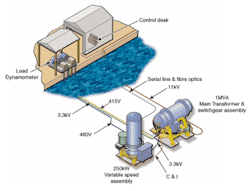PRODUCTION TECHNOLOGY: Power distribution unit an enabling technology for subsea components
One basic component to any subsea production processing, pumping, or separation system is a reliable power supply. In anticipation of moving these critical functions to the seabed, cont-ractor Alstom and producers BP, Shell, Norsk Hydro, and Chevron have worked on the design of a subsea electrical power distribution (Speed) system.
The Speed concept started as a joint industry project (JIP) five years ago when a former unit of Alstom began discussing the provision of a controlled power supply subsea with producers. Such a system could feed power to a variety of rotating subsea equipment devices. The key to applying this technology to rotating equipment is a variable drive that can operate in the high pressures of deepwater.
In a typical subsea scenario, a surface unit provides power to the seabed through a main cable. Each subsea unit requiring power has its own cabling link. This adds substantially to the overall cost of the project. If one cable can be routed to the seabed, and the power distributed among the various users, it would save on installation and operating costs and improve reliability by reducing the potential failure points.
Enabling system
Andy Peacock, Engineering Manager of General Drives for Alstom, says the Speed system is not so much a breakthrough in subsea production, as it is an enabling technology for equipment under development elsewhere. The company has identified users who could need such a system in the future.
The current Speed system is not yet ready, but has been through the conceptual design phase. Peacock said much of the technology involved is readily available. Alstom completed subsea trials of its first Speed prototype system in 1996, proving a range of technology building blocks and identifying areas where further development was required.
The current work on Speed is in an accelerated technology phase, ensuring that the key elements will be available. One technology gap required the development of a wet mate- able connector for 33 kV transmission. For this work, Alstom subcontracted Tronic, a part of the Expro Group, which had experience in this area. Another, broader area requiring innovative development was the design of a variable speed drive for the system. This drive would require no servicing and had to fit in a relatively small container.
Peacock explained that these parameters ran counter to the basics of surface system designs. On the surface, easy access to the internal workings of these units for maintenance and repair is critical. The systems are designed so that workers can quickly gain access all the components.
On the seabed, the unit would be located in a pressure vessel, requiring that it be as compact as possible. Also, there would be no opportunity to access the unit for maintenance. "We need an installation that needs no servicing," Peacock said.
Work to date
The wet mateable connector required for the Speed design has been manufactured and is in the process of being qualified. The technology is basically an extension of work Tronic was already doing. The variable speed drive, by contrast, is a one-off product, although based on a combination of Alstom's high reliability navy drives and standard industrial drive designs. Much of the preliminary work on Speed has been completed, and the product is under development, Peacock said.
Both of the electrical components and the pressure vessel are nearing completion, together with the heat exchanger system necessary to remove the waste heat generated by the drive. Peacock estimates this work will be complete by year's end.
Prototype
Once the design is complete, Peacock said, Alstom would like to find a sponsor for a prototype. This process would more than likely be driven by a particular application for the technology. That means the prototype would be part of a pilot program subsea.
Such applications are under discussion, but Peacock declined to reveal further details on this aspect of the project. He said that the design has reached a stage where it is necessary to know the specifics of the field where Speed would first be applied.
A target field and pilot project would allow Alstom to focus on the specific capabilities, water depths, and step-out distance from existing infrastructure. In the meantime, the design has been kept generic in terms of its capabilities. Peacock said the current Speed system is designed to operate in 4,500 ft water depth, although the company is also considering a design that would go twice as deep.
Waiting for subsea
As subsea processing systems, such as the Troll 1 Pilot, come onto the market, independent of the Speed development, they should stimulate interest in the project. Peacock said the potential for this technology is that it could offer a variety of solutions to the market.
For example, it might be possible at some point to power a number of subsea tiebacks from a centralized hub facility subsea. This would save substantially on installation costs and offer a solution for associated gas, which would be used to generate the power at the surface.
For areas where there is a lack of infrastructure, this system can reduce the topside footprint, freeing up space, and weight, for other equipment, or allowing the operator to installer a smaller production facility. There is also discussion of generating power offshore and using a version of this technology to transport it ashore. In developing nations this would provide a faster and more reliable source of electricity. Peacock said for the time being the commercialization of this system will take a backseat to the industry embracing subsea processing equipment.


